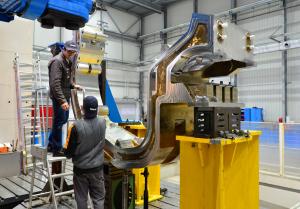Four years from prototypes to series
Hell is a balmy place when compared to the environment of a divertor cassette body. In the vicinity of this ITER component, heat loads will be comparable to those at the surface of the Sun, and radiation will be almost as intense as in the neighbourhood of a neutron star. Cassette bodies will also have to resist the huge mechanical forces that will be exerted for a few tens of milliseconds in the event of a severe plasma disruption. Rarely—even in the space or nuclear industries—has a component posed so many fabrication challenges.
From its strategic position at the bottom of the vacuum vessel, the ITER divertor is the component that will extract the heat and the helium ash from the burning plasma. The divertor is made up of 54 individual "cassette assemblies" arranged in a circle—each one formed from a structural backbone (the cassette body), actively cooled plasma-facing elements (the "targets" and the "dome"), and diagnostic systems.
"At ITER, we are used to dealing with systems that do not fit in the typical categories of industrial equipment," explains Laurent Ferrand, the ITER Technical Responsible Officer for the cassette bodies Procurement Arrangement. "When you first look at the technical specifications, what you see is a massive, complex stainless steel structure with lots of welds and very stringent welding and inspection requirements. But of course, it's much more than that ..."



